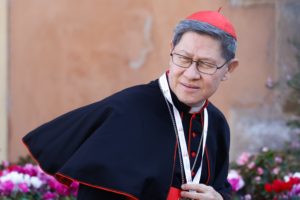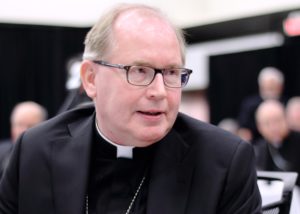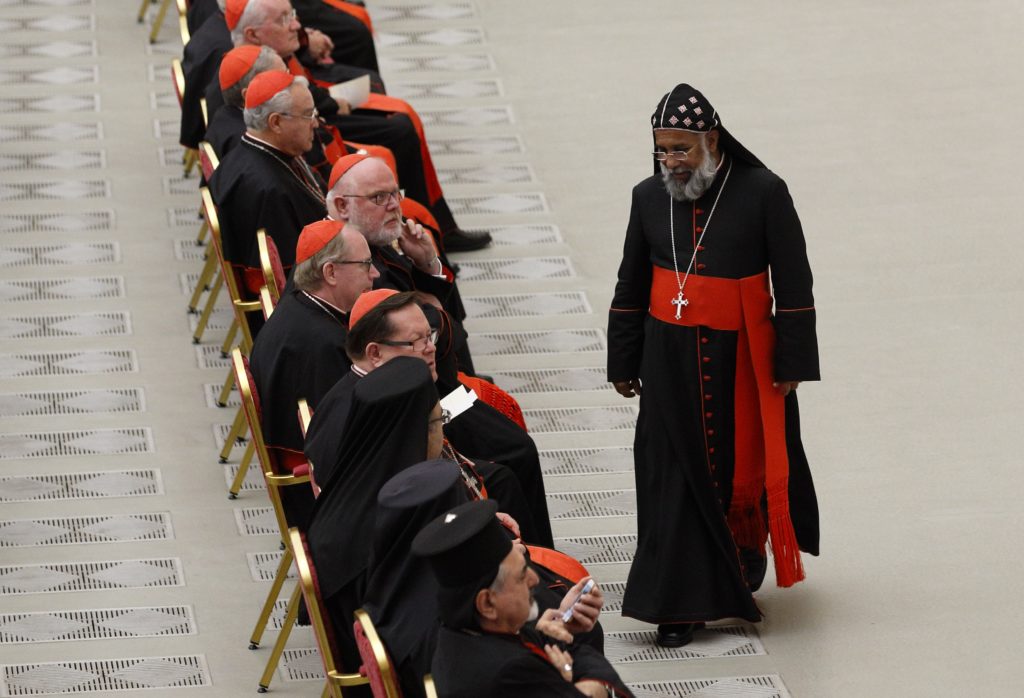ROME — With the death March 15 of German Cardinal Paul Cordes, a longtime stalwart of the papacies of both John Paul II and Benedict XVI, the total number of cardinals fell to 238. Because Cordes was 89, the number of cardinals under 80, and thus eligible to participate in the next conclave, remains unchanged at 129.
In all, there are still a robust total of 73 cardinals over the age of 80 who were appointed by either John Paul or Benedict, meaning the institutional memory of those papacies is still very much alive within the college.
Even among those cardinals under 80, there’s still a healthy 34 Princes of the Church who date from the two papacies prior to Pope Francis — eight appointed by John Paul, and the remaining 26 by Benedict. The longest-serving of that group is Cardinal Vinko Puljić, the retired archbishop of Sarajevo, who was given his red hat by John Paul in 1994, and who today is 78.
(The cohort of voting-age cardinals named by previous popes will fall to 32 in June, when both Canadian Cardinal Marc Ouellet and American Cardinal Sean O’Malley of Boston turn 80.)
The youngest member of the group is Cardinal Baselios Cleemis Thottunkal, head of India’s Syro-Malankara church, who’s just 64, and who was made a cardinal by Benedict XVI in 2012. As a result, Francis theoretically would have to reign another 16 years, to the highly unlikely age of 103, before the body of cardinal-electors would be composed entirely of his selections.
The last time a papal election took place, in 2013, the roster was uniformly made up of cardinals named by either John Paul or Benedict, in large part because John Paul had such a long papacy at almost 27 years.
Surveying the lineup of voting-age cardinals who are holdovers from previous administrations, what seems most striking is how they seem to run the gamut from enthusiastic allies and supporters of Francis to plausible alternatives when the time comes to make a choice between continuity and change.

Among cardinals appointed by previous popes who nonetheless seem identified with this one, there’s Cardinal Oswald Gracias of Mumbai, for example, a longtime member of Francis’ council of cardinal advisers, and Cardinal Christoph Schönborn of Vienna, who emerged as a forceful defender of Francis’ cautious opening to Communion for divorced and civilly remarried Catholics in 2016’s Amoris Laetitia (“The Joy of Love”).
Also in this group would be Argentinian Cardinal Leonardo Sandri, former head of the Vatican’s Dicastery for Eastern Churches and currently the vice-dean of the College of Cardinals. Named a cardinal by Benedict in 2007, Sandri also has been a reliable ally of Francis, and today serves on a jury in Abu Dhabi that awards an annual prize named for “human fraternity,” the key concept in a joint document signed by Francis and Sheikh Ahmed el-Tayeb, Grand Imam of Al-Azhar, in 2019.
Probably the best examples, however, of cardinals who rose up under previous popes but who’ve thoroughly embraced the new regime would be Cardinal Luis Antonio “Chito” Tagle of the Philippines, currently pro-prefect of the Vatican’s Dicastery for Evangelization, and Cardinal João Bráz de Aviz of Brazil, who heads the Dicastery for Institutes of Consecrated Life and Societies of Apostolic Life, better known as the “Dicastery for Religious.”
Honestly, it’s difficult even for seasoned Vatican-watchers to recall that Tagle and Bráz were both named cardinals by Benedict, so identified are they with the vision and outlook of the Francis era. Indeed, some observers regard the 66-year-old Tagle as a plausible candidate for the papacy himself among those cardinals wishing to continue the Francis agenda.
(Actually, the single best choice for a cardinal named by a previous pope who’s completely identified himself with Francis is Cardinal Óscar Rodríguez Maradiaga of Honduras, the longtime coordinator of the council of cardinals, but he’s now 81.)
On the other hand, there are several figures among the holdover cardinals who are perceived to represent a somewhat more conservative and traditionally minded option in Catholicism, some of whom continue to be important points of reference in Church affairs.

That group includes Cardinal Péter Erdő of Budapest, who was named a cardinal by John Paul in 2003. A canon lawyer by training, Erdő recently led the Hungarian bishops in essentially rejecting the Vatican document Fiducia Supplicans (“Supplicating Trust”), which authorized nonliturgical blessings of same-sex unions. A Dec. 27 statement from the bishops instructed priests to avoid blessing same-sex couples.
There’s also Cardinal Cardinal Wim Eijk of Utrecht in the Netherlands, a noted conservative who helped lead the opposition to Amoris Laetitia in 2016, and who also scolded Francis in 2018 for failing to reprimand the German bishops for a draft proposal that would allow Protestants to receive the Eucharist under certain circumstances. By failing to publicly reject the idea, Eijk warned, Francis was promoting “a drift towards apostasy.”
Like Erdő, Eijk also recently joined his fellow Dutch bishops in distancing themselves from Fiducia Supplicans.
One might also point to Cardinal Malcolm Ranjith of Sri Lanka, who served as the No. 2 official in the Vatican’s Congregation for Divine Worship and the Discipline of the Sacraments from 2005 to 2009, where he was known as il piccolo Ratzinger (“Little Ratzinger”), in part for his short stature and in part for his affinity with Benedict. Ranjith has largely stayed out of the controversies during the Francis era, but those who remember his time in Rome haven’t forgotten his provenance.
Also among the holdovers are figures even more clearly identified with the opposition to Francis, including Cardinal Raymond Burke of the United States and Cardinal Robert Sarah of Guinea, both elected to the college by Benedict in the same consistory in November 2010.
So, what can we conclude from this survey of cardinals named by previous popes who nevertheless remain important players today?
If nothing else, probably this: Just because a cardinal was appointed by one pope doesn’t mean he’s automatically going to favor a photocopy as that pope’s successor. Some will want continuity, while others will embrace change. Therefore, don’t get too comfortable with the idea that since Francis has named a preponderance of the cardinals who will elect his successor, we can guess the result.
It has never been thus, and there’s no special reason to assume it will be this time either.

